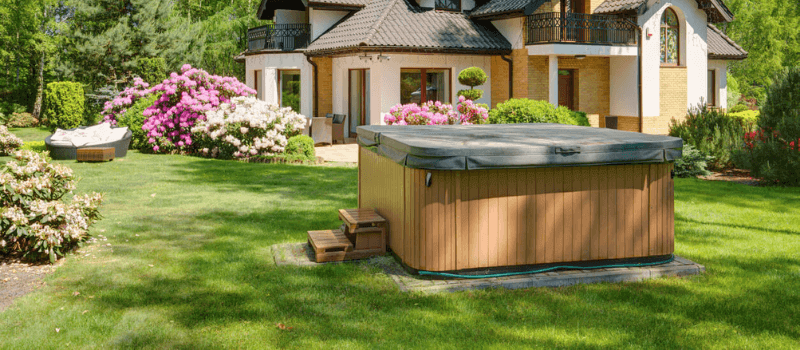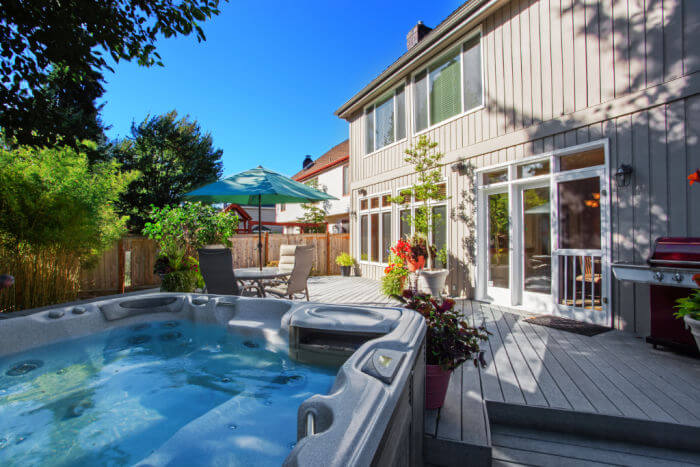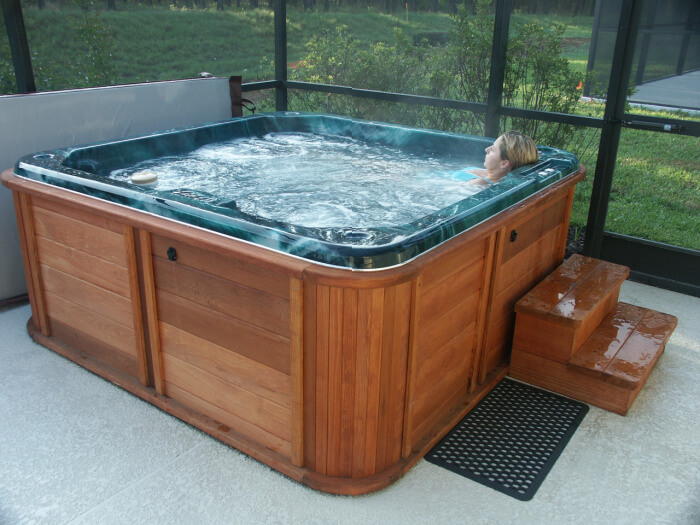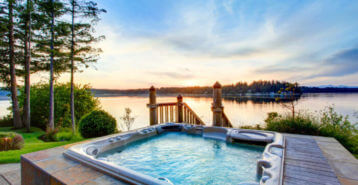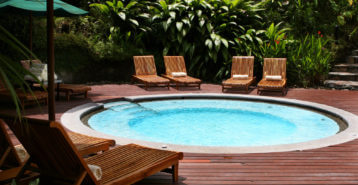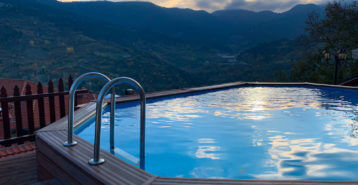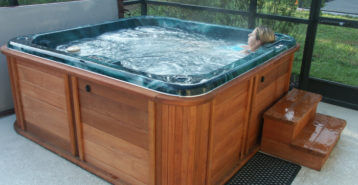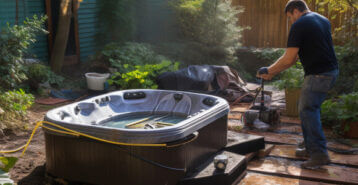Installing a new hot tub is one of the most exciting home improvement projects because of the entertainment and relaxation it can bring to your home. When deciding to add a new hot tub to your yard, you will discover there are two main choices – portable hot tubs and in-ground hot tubs.
Portable hot tubs, also known as above ground hot tubs, continue to gain popularity due to their affordable price point, versatility and convenience. Modernize has created this comprehensive guide for understanding everything you need to know about portable hot tubs – including costs, types, and sizes – prior to planning an installation.
What is a Portable Hot Tub?
A portable hot tub is simply a hot tub spa that is above ground, rather than in-ground (built into the ground or landscaping).
There are many reasons why homeowners enjoy portable hot tubs. Their versatility allows you to place them on virtually any flat surface in your yard – whether it’s on your patio, on a flat concrete surface in your backyard, or elsewhere. These hot tubs also come in a variety of materials, designs, levels of energy-efficiency, seating options, and offer a wide selection of features to choose from. Additionally, above ground hot tubs tend to be more affordable than in-ground hot tubs, and you can take them with you if you move.
How Much Does a Portable Hot Tub Cost?
You can expect portable hot tubs to be more affordable compared to in-ground hot tubs – both for installation and operational costs. But just how much do they cost?
The cost of a portable hot tub mainly depends on the quality, features, and size.
- Basic portable hot tubs will include the most common and generic spa features and will accordingly be the most affordable – at just $3,000 to $5,000.
- Mid-range hot tubs will cost slightly more at around $5,000 to $10,000, giving you higher quality features.
- Luxury hot tub models will cost the most at about $10,000 and up. However, they will provide the highest quality experience, with features such as ergonomic molded seating, 100+ massage jets, sound systems, and more.
Keep in mind that in addition to quality and features, sizing also plays a role in the installation cost for a portable hot tub. As a rule of thumb, larger hot tubs with an upwards of 10 seats will cost more than a small 4 person hot tub.
Maintenance Costs
Of course, portable hot tubs require electricity and heating to operate. This means that the more you use your hot tub, the more it will likely cost you in the form of monthly energy and utilities. Normally, the size of the heater (in terms of wattage) will impact the cost of energy usage.
The good news is that portable hot tubs are usually more energy-efficient and cost less to operate compared to in-ground hot tubs. If you are looking to lower your monthly operational costs, it is worth it to look into energy-efficient models with high-quality insulation and adjustable jet settings that you can control.
Benefits of Portable Hot Tubs
Explore a few of the many reasons portable hot tubs are so popular among homeowners today.
Disadvantages of Portable Hot Tubs
While there are plenty of benefits, its worth noting the possible limitations of above ground hot tubs before choosing to install one.
Types of Portable Hot Tubs
There are two main types of portable hot tubs available – inflatable and hard shell. Hard shell hot tubs are more popular and are made with higher quality.
Inflatable hot tubs
Inflatable hot tubs are cheap, DIY hot tubs that can be installed on your own. While this type of hot tub is easily portable and a “plug and play” option, it’s important to keep in mind their downsides. Inflatable hot tubs usually have a maximum 5 year lifespan, have shallow water levels, are uninsulated, and do not have built-in seating.
Hard shell hot tubs
High-quality portable hot tubs come in the form of hard shell hot tubs. Hard shell portable hot tubs can last 20 or more years, have built-in seating and energy-efficient insulation, include massage jets, and have a high weight and water capacity. If you are looking for a portable hot tub that is built to last, hard shell models are your best bet.
Materials
When thinking about the materials for your hot tub, consider both the hot tub’s exterior and interior. Portable hot tubs have an exterior layer called the “shell” or “cabinet,” which is typically made from a synthetic acrylic or fiberglass material, but often appears like real wood. One benefit of this synthetic shell is that it is designed to be weather-resistant, durable, insulated, and easy to clean. Homeowners can usually choose from a variety of colors and textures for this exterior shell – for instance, a mahogany, marble, or cedar finishing.
For the interior of the hot tub, the most common materials are vinyl, rotomolded plastic, and acrylic. The most durable and long-lasting material is acrylic. For portable hot tubs, the interior material is usually molded with built-in seating for added comfort.
In terms of insulation, the best portable hot tubs use a layer of multi-density and fibercor foam to keep water hot and energy-efficient. Hot tubs with full or partial foam insulation (as opposed to multi-density) will be less energy-efficient but likely more affordable.
Sizing and Dimensions for Portable Hot Tubs
Compared to in-ground hot tubs, which have customized sizes, portable hot tubs are pre-fabricated and therefore come in set sizes. Homeowners will choose the exact hot tub size they want from the manufacturer’s list offerings prior to installation.
For this reason, homeowners should measure the area in which they plan to place their hot tub, as well as the seating they want, before choosing a hot tub make and model. If you plan to install the hot tub on your patio, measure the area and make sure the dimensions will fit comfortably, with extra room around the spa for guests to move around.
Above-ground hot tubs are larger than in-ground hot tubs due to their added height. Many portable hot tubs are also available in larger sizes compared to the typical in-ground hot tub. Take a look at the common dimensions for portable hot tubs based on the number of seats to better plan for the installation:
| Small (2 to 4 seats) | 5’4” to 7” Width
29” – 35” Height |
| Mid-size (4 to 6 seats) | 6’6” to 7’9” Width
33” – 39” Height |
| Large (7 or more seats) | 7’7” to 9” Width
36” – 39” Height |
Features and Accessories
Selecting add-on features and accessories for your above ground hot tub can truly personalize the experience. Here are several of the most common add-on features and accessories homeowners choose when installing a portable hot tub.
Above-Ground vs. In-Ground Hot Tubs
When it comes down to it, homeowners who want to install a new hot tub in their yard will have to choose between above-ground and in-ground models.
The main difference between portable hot tubs and in-ground hot tubs is that portable hot tubs can be moved and placed anywhere in a homeowner’s yard. In-ground hot tubs are a permanent solution that cannot be moved or relocated. If you invest in a portable hot tub, you would be able to take it with you if you decide to move to another home. You would not get the same benefit with an in-ground hot tub.
Beyond portability, above ground hot tubs have other advantages over in-ground hot tubs. They use less energy, are more affordable, and contain more jets.
To help guide your decision, we have provided a run-down of circumstances that lend themselves best to above-ground hot tubs vs. in-ground hot tubs.
| An above ground hot tub is best for: | An in-ground hot tub is best for: |
|---|---|
| Colder weather | Homeowners with pools |
| Patios or stand-alone placement | Customized appearance |
| Resale value | Permanent solution |
In-ground hot tubs are better for homes with existing pools, or when a homeowner plans to build one. They are also better in creating a “natural look” that blends into your backyard’s landscaping. An in-ground hot tub will boost the value of your home. But keep in mind that you will not be able to resell the spa itself.
Consider that portable hot tubs can be placed closer to the home, which makes them ideal for cold weather when you don’t want to trek through your yard to reach your hot tub. Portable hot tubs are also better for patios, and they can be resold if you decide you no longer wish to own one.
Preparing for Installation
Luckily, portable hot tubs are very easy to set up and install. But you should still be prepared for installation day to ensure the process goes as smoothly as possible.
Once speaking with a professional and choosing a model, the company will deliver the above ground hot tub spa directly to your home. All you need to do is find a flat, level surface where you want the hot tub to be situated. Sometimes, the professional may suggest pouring a level pad of concrete to support the hot tub if your space is not quite flat enough.
The area should have easy access to a source of electricity, and ideally a water source for filling the tub. Portable hot tubs require either 110V or 220V of electricity to operate. If you go with a 110V model, you will likely be able to simply plug the hot tub into an outdoor outlet and use it immediately. For 220V models, an electrician’s work is often required for installation. Also consider trees and foliage in the area, as you may want to avoid an area that is especially prone to fallen leaves and debris.
To further guide you in your research, take a look at our ranked list of the top 10 hot tub brands and our full hot tub buying guide.
If you are ready to speak with a professional about installing a portable hot tub at your home, Modernize can help. Our network of hot tub professionals are highly qualified and ready to speak with you about adding a brand new hot tub to your yard.
Compare top-rated hot tubs pros in your area.
Read real homeowner reviews, explore qualifications, and view promotions. Modernize makes it easy to browse professionals and find one that will be perfect for your project.

